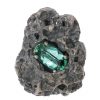Uranos Silver 5.005
A bluish-green 1.0 ct tourmaline set in a matt-black pendant.
This gemstone has two different colour tones making it a very rare specimen indeed. The different colours as well as the abundant reflections of each colour shade end up creating such a broad spectrum of shimmering light. It is as if you could watch the magic rays of light perform their cosmic dance.
gemstone details
- Gemstone: tourmaline
- Weight (ct): 0.99
- Cut: oval
- Color: bluish-green
- Dimension (mm): 8.1 x 4.8 x 3.6
Pendant details
- Material: 15.40 g silver
- Surface: matt black
price
1993.57 $
Share
tourmaline
The name origin of tourmaline comes from the Singalese word “turamali” meaning “stone of mixed colour”.
An old Egyptian legend tells the tale of a tourmaline making the arduous journey from the centre of the earth up to the surface and then ascending all the way up to the sun on the back of a rainbow. For this reason it is still called the rainbow gem to this very day.
Tourmaline was a well known gem in the Mediterranean region from ancient times onward but was only introduced to West and Central Europe from Ceylon by the Dutch in 1703. It then took a further 200 years for the chemical formula of this complex mineral to be determined.
The great colour array of tourmaline is due to the trigonal crystal system of which it is made up of. This crystal structure gives it its high level of hardness reaching 7 -7.5 on the Mohs scale and also allows entrapment of many different elements that create the magnificent spectrum of colours either individually or in conjunction with each other. The colour can even vary within the same stone resulting in the so-called greeny-red “Watermelon Tourmaline” which is especially popular.
A further characteristic of this group is the distinctive display of dichroism or pleochroism (multi colour) where, depending on angle of observation and light conditions, varying degrees of colour intensity and even different colour hues become visible. No wonder this gemstone was no end of fascination to both Kings and Pharaohs alike.
The colours that are particularly popular In the manufacture of jewellery are red (Rubelite), green (Verdelite), blue (Indigolite), yellowy-brown (Dravite), pinky red -violet blue (Siberite) and black (Schorl).




